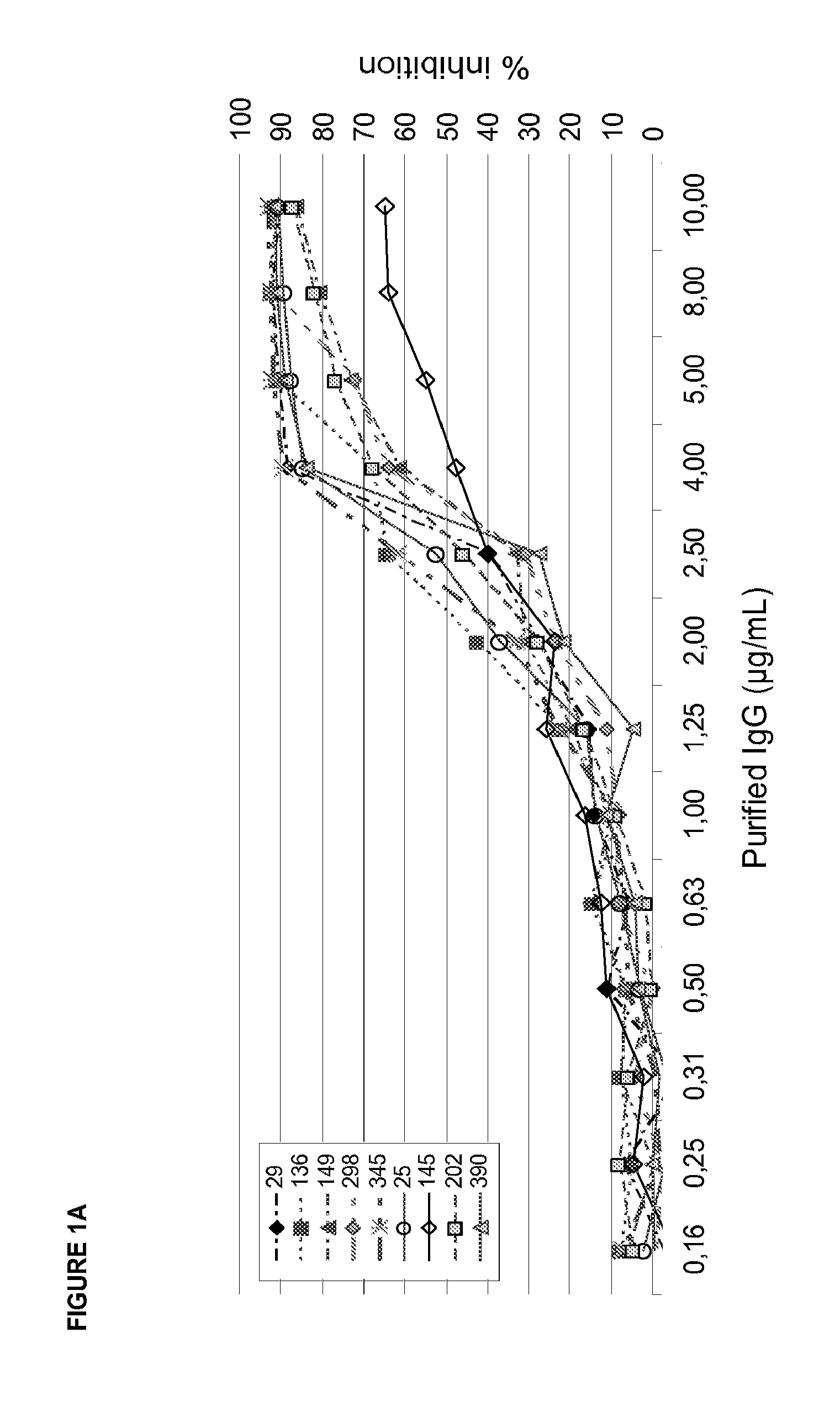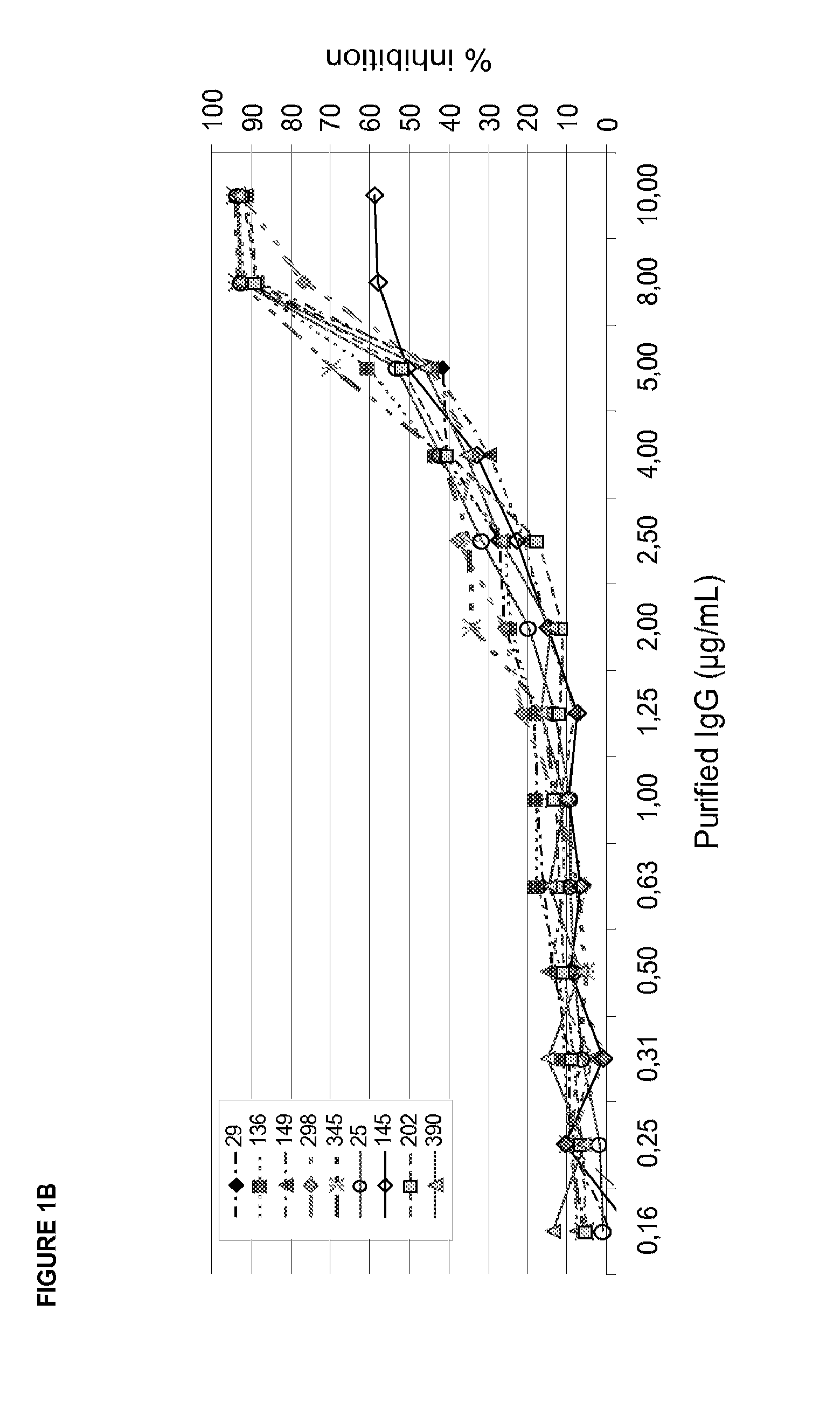Antagonist antibodies and their fab fragments against GPVI and uses thereof
a technology of anti-gpvi and fab fragments, which is applied in the field of anti-gpvi anti-fab fragments and their fab fragments, can solve the problems of limited efficacy of the currently available drugs, large unmet medical needs for new treatments, and limited use, so as to prevent platelet activation
- Summary
- Abstract
- Description
- Claims
- Application Information
AI Technical Summary
Benefits of technology
Problems solved by technology
Method used
Image
Examples
example 1
Generation of Recombinant Extracellular D1 and D2 Domain of GPVI
[0168]A—Construction of hGPVI-hFc Fusion Expression Plasmid (hGPVI-hFc)
[0169]Using human cDNA containing plasmids as a PCR template, a DNA fragment encoding a 237 amino acid residue heavy chain constant region including the hinge region, CH2 and CH3 domains of human immunoglobulin IgG was amplified.
[0170]Using human genomic DNA as PCR template, a DNA fragment encoding a 205 amino acid residue human GPVI D1 and D2 extracellular domains was amplified. This human GPVI D1 and D2 fragment includes the signal sequence and corresponds to amino acids M1 to T205 in the wild type protein (NP—057447 / Q9HCN6). The resulting amplified, cleaved and purified PCR products encoding human GPVI D1 and D2 and a human Fc region were combined by ligation PCR and ligated into baculovirus expression vector pVL1393 by InFusion method using EcoRI and NotI site. The resulting GPVI-Fc ORF is listed as SEQ ID NO.1 and its corresponding protein seque...
example 2
Generation and Selection of Functional Anti-GPVI mAbs
[0178]A—Generation of Anti-GPVI mAbs
[0179]GPVI-specific antibodies were generated using the RIMMS method as described by Kilpatrick et al. (1997. Hybridoma 16: 381389).
[0180]6-8 weeks old female BALB / c mice (S082342; Charles River Labs, Bar Harbor, Me.) each received four rounds of immunization with purified soluble his-tagged GPVI protein (prepared as described in Example 1) over a course of 14 days at intervals of 3-4 days.
[0181]For the first immunization on day zero, 5 μg antigen emulsified in Titermax's adjuvant (TierMax Gold Adjuvant; Sigma #T2684) was administered subcutaneously to six sites proximal to draining lymph nodes, along the back of the mice. Another 5 μg of antigen emulsified in RIBI's adjuvant (Sigma Adjuvant system; Sigma #S6322) was administered to six juxtaposed sites along abdomen. Booster immunizations were given on days 4, 7 and 11 in a similar fashion.
[0182]Four days after the last injection, mice were sac...
example 3
Preparation and Biophysical Properties of Anti-GPVI mAbs and their Fab Fragments
[0207]A—Inhibition of Collagen Binding to Recombinant GPVI by Anti-GPVI IgG's or their Proteolytic Fab Fragments
[0208]Collagen coated 384well plates (Pierce) were blocked with 3% BSA for 2 h. Increasing concentrations of IgG or its corresponding Fab fragment produced by Ficin cleavage (0.3-20 μg / ml) were incubated with recombinant GPVI (Fc-fusion protein of the extracellular GPVI domain; 3 μg / ml) for 30 min. The GPVI-IgG mixture was added to collagen coated plates and incubated for 1 h at RT. Next, 384well plates were washed (DELFIA wash buffer, Perkin Elmer) five times and Eu-labelled anti-human IgG (100 ng / ml Perkin Elmer) was added. Following 1 h incubation at room temperature plates were washed again five times, enhancement solution (Perkin Elmer) was added and incubated for 10 min. Fluorescence was detected at 360 / 612 nm using a Tecan Ultra reader. FIG. 3 shows a typical readout. Table 4 shows calcu...
PUM
 Login to View More
Login to View More Abstract
Description
Claims
Application Information
 Login to View More
Login to View More - R&D
- Intellectual Property
- Life Sciences
- Materials
- Tech Scout
- Unparalleled Data Quality
- Higher Quality Content
- 60% Fewer Hallucinations
Browse by: Latest US Patents, China's latest patents, Technical Efficacy Thesaurus, Application Domain, Technology Topic, Popular Technical Reports.
© 2025 PatSnap. All rights reserved.Legal|Privacy policy|Modern Slavery Act Transparency Statement|Sitemap|About US| Contact US: help@patsnap.com



